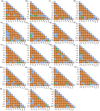Comparative genomics of thermosynechococcaceae and thermostichaceae: insights into codon usage bias
- PMID: 39845100
- PMCID: PMC11750575
- DOI: 10.3389/abp.2024.13825
Comparative genomics of thermosynechococcaceae and thermostichaceae: insights into codon usage bias
Abstract
Members of the families Thermosynechococcaceae and Thermostichaceae are well-known unicellular thermophilic cyanobacteria and a non-thermophilic genus Pseudocalidococcus was newly classified into the former. Analysis of the codon usage bias (CUB) of cyanobacterial species inhabiting different thermal and non-thermal niches will benefit the understanding of their genetic and evolutionary characteristics. Herein, the CUB and codon context patterns of protein-coding genes were systematically analyzed and compared between members of the two families. Overall, the nucleotide composition and CUB indices were found to differ between thermophiles and non-thermophiles. The thermophiles showed a higher G/C content in the codon base composition and tended to end with G/C compared to the non-thermophiles. Correlation analysis indicated significant associations between codon base composition and CUB indices. The results of the effective number of codons, parity-rule 2, neutral and correspondence analyses indicated that mutational pressure and natural selection primarily account for CUB in these cyanobacterial species, but the primary driving forces exhibit variation among genera. Moreover, the optimal codons identified based on relative synonymous codon usage values were found to differ among genera and even within genera. In addition, codon context pattern analysis revealed the specificity of the sequence context of start and stop codons among genera. Intriguingly, the clustering of codon context patterns appeared to be more related to thermotolerance than to phylogenomic relationships. In conclusion, this study facilitates the understanding of the characteristics and sources of variation of CUB and the evolution of the surveyed cyanobacterial clades with different thermotolerance and provides insights into their adaptation to different environments.
Keywords: codon usage; evolution; natural selection; thermostichaceae; thermosynechococcaceae.
Copyright © 2025 Mou, Hu, Zhang, Daroch and Tang.
Conflict of interest statement
The authors declare that the research was conducted in the absence of any commercial or financial relationships that could be construed as a potential conflict of interest.
Figures




Similar articles
-
Evolution of Codon Usage Bias in Diatoms.Genes (Basel). 2019 Nov 6;10(11):894. doi: 10.3390/genes10110894. Genes (Basel). 2019. PMID: 31698749 Free PMC article.
-
Compare Analysis of Codon Usage Bias of Nuclear Genome in Eight Sapindaceae Species.Int J Mol Sci. 2024 Dec 24;26(1):39. doi: 10.3390/ijms26010039. Int J Mol Sci. 2024. PMID: 39795897 Free PMC article.
-
Analysis of codon usage bias of thioredoxin in apicomplexan protozoa.Parasit Vectors. 2023 Nov 21;16(1):431. doi: 10.1186/s13071-023-06002-w. Parasit Vectors. 2023. PMID: 37990340 Free PMC article.
-
Comparative Analysis of the Codon Usage Pattern in the Chloroplast Genomes of Gnetales Species.Int J Mol Sci. 2024 Oct 2;25(19):10622. doi: 10.3390/ijms251910622. Int J Mol Sci. 2024. PMID: 39408952 Free PMC article.
-
Codon usage bias.Mol Biol Rep. 2022 Jan;49(1):539-565. doi: 10.1007/s11033-021-06749-4. Epub 2021 Nov 25. Mol Biol Rep. 2022. PMID: 34822069 Free PMC article. Review.
References
Publication types
MeSH terms
Substances
LinkOut - more resources
Full Text Sources
Miscellaneous

